Grand Title Winner 2018, Animal Portraits: The golden couple, by Marcel Van Oosten, The Netherlands (pictured above)
A male Qinling golden snub-nosed monkey rests briefly on a stone seat. He has been joined by a female from his small group. Both are watching intently as an altercation takes place down the valley between the lead males of two other groups in the 50-strong troop.
It’s spring in the temperate forest of China’s Qinling Mountains, the only place where these endangered monkeys live. They spend most of the day foraging in the trees, eating a mix of leaves, buds, seeds, bark and lichen, depending on the season. Though they are accustomed to researchers observing them, they are also constantly on the move, and as Marsel couldn’t swing through the trees, the steep slopes and mountain gorges proved challenging.
Whenever he did catch up and if the monkeys were on the ground, the light was seldom right. Also, the only way to show both a male’s beautiful pelage and his striking blue face was to shoot at an angle from the back. That became Marsel’s goal.
It took many days to understand the group’s dynamics and predict what might happen next, but finally his perseverance paid off with this gift of a perfect situation, with a perfect forest backdrop and perfect light filtering through the canopy. A low flash brought out the glow of the male’s golden locks to complete the perfect portrait.
Grand Title Winner 2018, 15-17 Years Old, Lounging leopard by Skye Meaker, South Africa
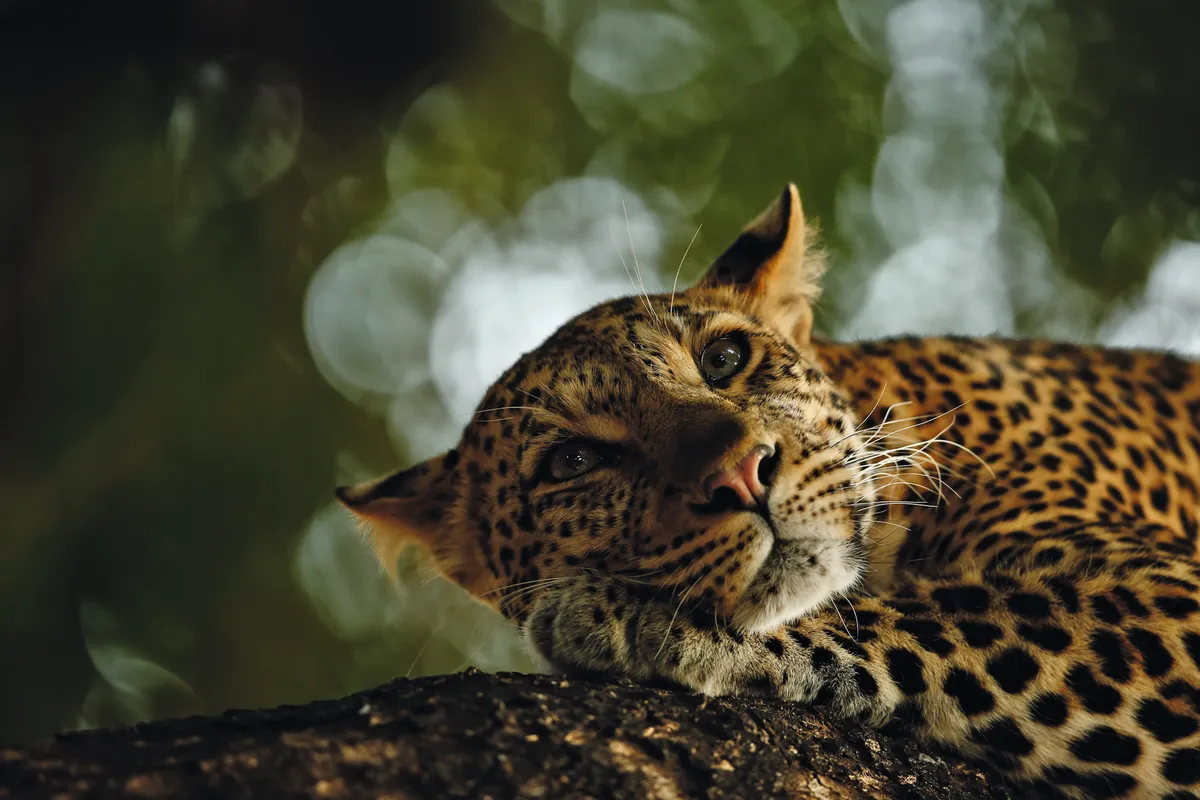
Mathoja was dozing when they finally found her, lying along a low branch of a nyala tree. And she continued to doze all the time they were there, unfazed by the vehicle. "She would sleep for a couple of minutes. Then look around briefly. Then fall back to sleep," says Skye.
Mathoja’s home is Botswana’s Mashatu Game Reserve, which Skye and his family regularly visit, always hoping to see leopards, though they are notoriously elusive. In Bantu language, Mathoja means ‘the one that walks with a limp’. Skye calls her Limpy. She limps because of an injury as a cub, but otherwise she is now a healthy eight-year-old, and she remains the calmest of leopards around vehicles.
Though she dozed just metres away from Skye, she blended into the background, the morning light was poor, leaves kept blowing across her face, and her eyes were only ever open briefly, making it hard for Skye to compose the shot he was after. Finally, just as she opened her eyes for a second, the overhead branches moved enough to let in a shaft of light that gave a glint to her eyes, helping him to create his memorable portrait.
Winner 2018, 10 Years and Under, Pipe owls by Arshdeep Singh, India
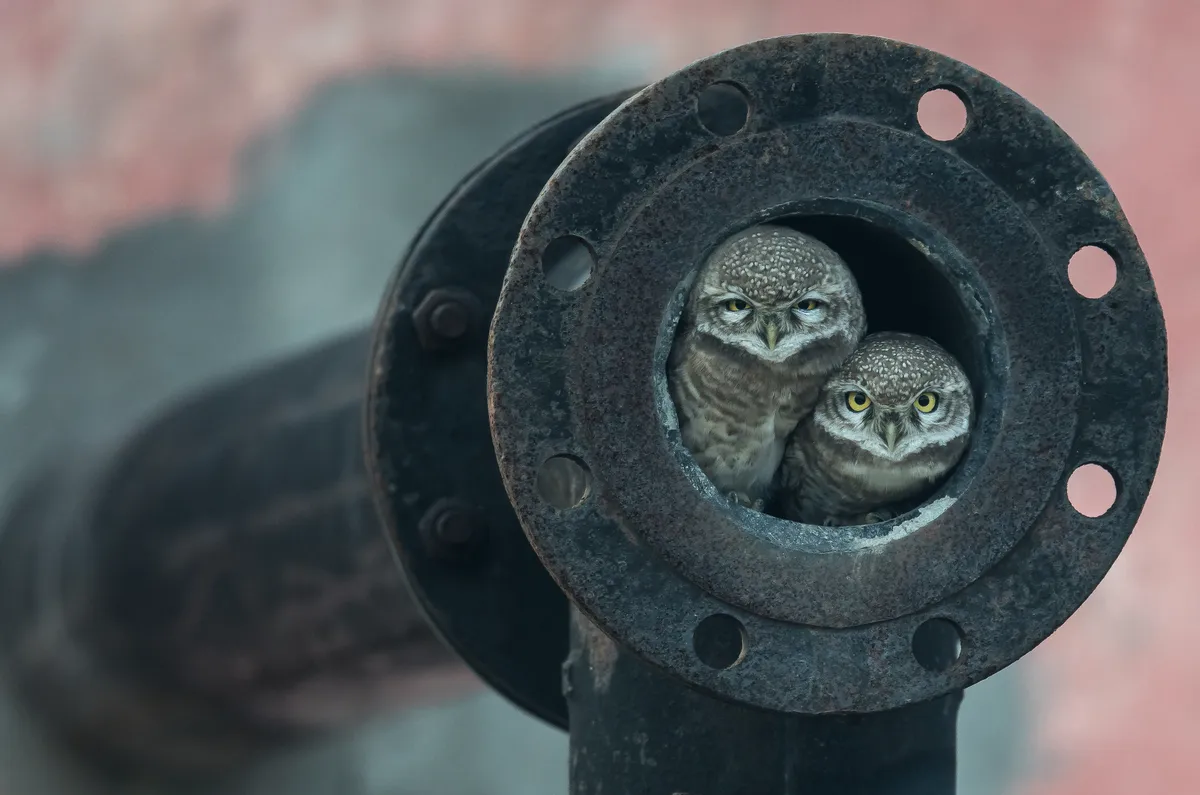
Huddled together at the opening of an old waste-pipe, two spotted owlets look straight into Arshdeep’s lens. He and his father had been driving out of Kapurthala, a city in the Indian state of Punjab, going on a birding trip, when he saw one of them dive into the pipe. His father didn’t believe what he’d seen but stopped the car and backed up. It wasn’t long before one of the owlets popped its head out.
Guessing this might be a nest site and keen to photograph such an unusual setting, Arshdeep begged to borrow his father’s camera and telephoto lens. Using skills accrued from photographing birds since he was six years old, Arshdeep rested the lens on the car’s open window and waited. He wasn’t at eye level, though. Realizing that if the window was half open, he could place the lens at the right height, he knelt on the seat and waited.
It wasn’t long before the curious owlet – less than 20 centimetres (8 inches) high – put its head out again, closely followed by the larger female. Framing the pair off-centre, and using a shallow depth of field to isolate them from the building behind, he created a characterful portrait of a species that has adapted to urban life.
Winner 2018, 11-14 Years Old, Duck of dreams by Carlos Perez Naval, Spain
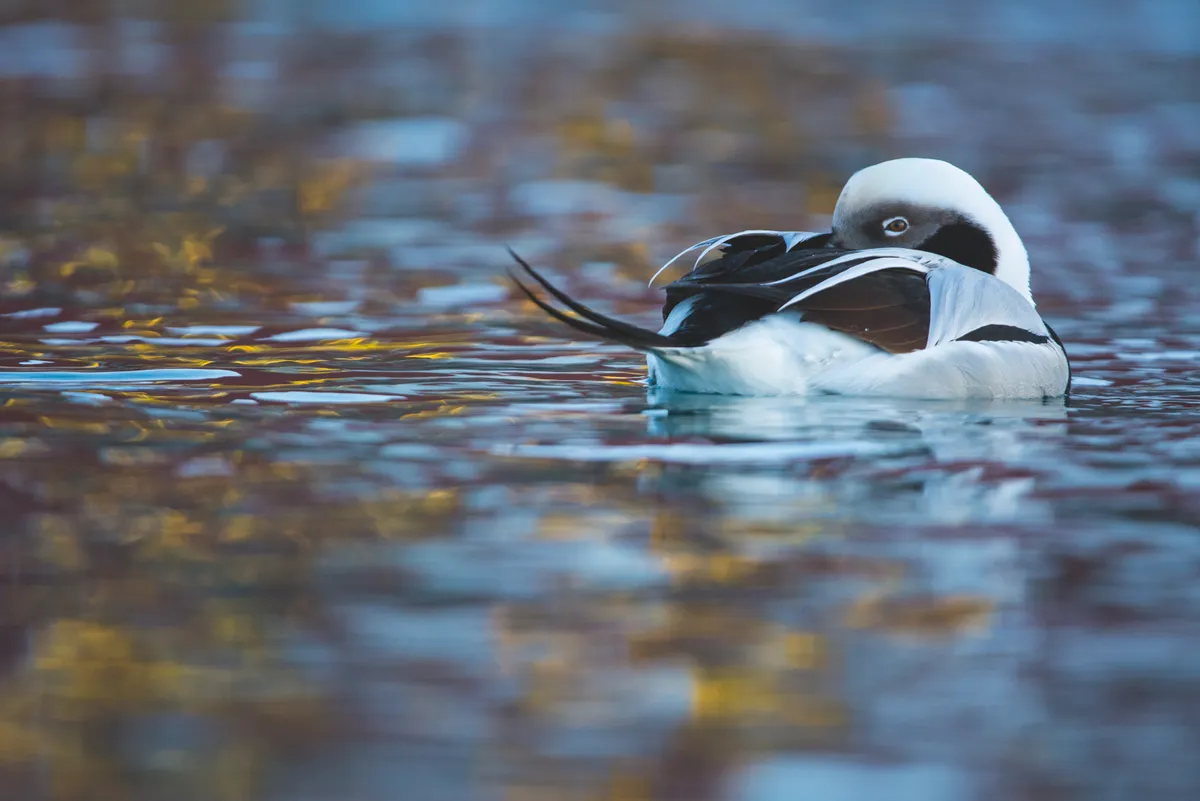
The long-tailed ducks were the most beautiful Carlos had ever seen. In fact, it had been the sea ducks that he most wanted to see when the family planned their holiday to Norway. They were staying on the Varanger Peninsula, on the northern coast of the Barents Sea.
But to get close enough to photograph the ducks meant booking a floating hide in the harbour and an early-morning boat, so he and his mother and father would be in the hide before sunrise, before the ducks flew in to feed. It was March, and still bitterly cold, and lying on his belly on the floor of the hide, he felt he might gradually freeze. But the discomfort was worth it.
As the light broke, the ducks flew in – eider ducks and long-tailed ducks in their breeding plumage. The only sound was the water lapping against the hide as the ducks dived for fish. He focused on one male that was resting after feeding. An overcast sky muted the dawn light and allowed Carlos to capture the subtle colours of the duck’s plumage, and reflected lights from the village added a golden sparkle to the ripples, caught in a perfect frame.
Winner 2018, Animals in their environment, Bed of seals by Cristobal Serrano, Spain
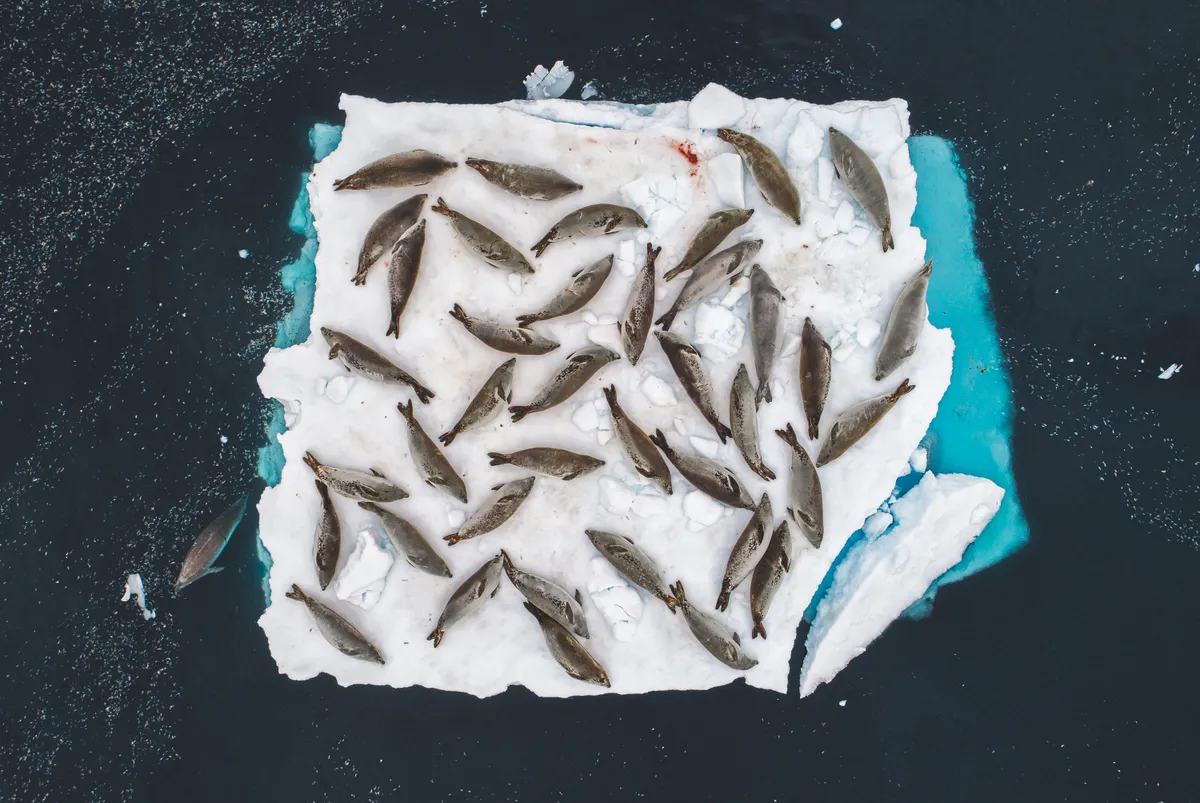
A small ice floe in the Errera Channel at the tip of the Antarctic Peninsula provides barely enough room for a group of crabeater seals to rest, and the cracks are starting to show. It’s the end of summer in the Antarctic, and so sea ice here is in short supply. Crabeater seals are widespread in Antarctica and possibly the most abundant of all seals anywhere. But they are also dependent on sea ice, for resting, breeding, avoiding predators such as killer whales and leopard seals, and accessing feeding areas.
Despite their name, crabeaters are adapted to feed almost exclusively on Antarctic krill, using their interlocking, finely lobed teeth to sieve krill from the water. The krill itself is also dependent on sea ice, which provides winter shelter and food (algae). So any decline in sea ice will have a knock-on effect on such specialist krill predators, as will overfishing of krill. For the moment, there is no evidence of any decline in crabeaters, though in the vastness of their pack-ice habitat, it is very difficult to estimate their numbers.
Positioned in a rubber dinghy in the channel beside the floe, Cristobal waited until the sea was relatively calm before launching his drone. The batteries would not last long in the cold, so he flew the drone "high and smoothly … using low-noise propellers to avoid disturbing the seals". The picture portrays the group, dozing, with a spattering of krill-coloured seal excrement symbolizing their dependence on Antarctica’s keystone species.
Winner 2018, Behaviour: Amphibians and Reptiles, Hellbent by David Herasimtschuk, USA
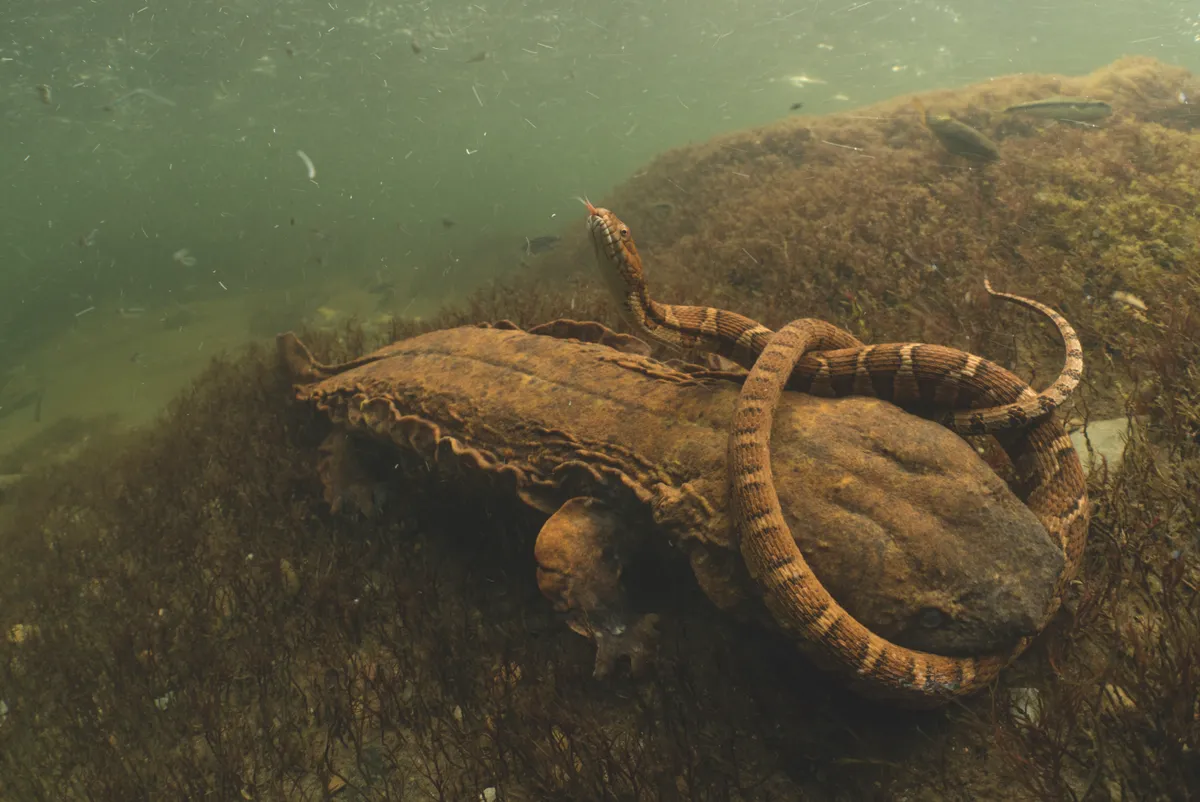
It was not looking good for the northern water snake, clamped tightly in the jaws of a hungry hellbender, but it was a remarkable find for David. Drifting downstream in Tennessee’s Tellico River, in search of freshwater life (as he had done for countless hours over the past seven years), he was thrilled to spot the mighty amphibian with its struggling prey.
North America’s largest aquatic salamander – up to 75 centimetres (29 inches) long – the hellbender has declined significantly because of habitat loss and degradation of the habitat that remains. Breathing primarily through its skin and seeking shelter and nest sites under loose rocks, it favours cool, flowing water in clear rocky creeks and rivers. Its presence indicates a healthy freshwater ecosystem.
"It looked as though the hellbender had a firm grip and the snake was tiring," says David, ‘but then the snake squeezed its powerful body against the hellbender’s head.’ When the attacker tried to reposition its bite, wrinkly folds of skin rippling, the snake pushed free from its jaws and escaped. The intense drama was over in just a few minutes, but with quick reactions, David captured this rarely seen behaviour, portraying the ‘diabolic charisma’ of the giant hidden just beneath the surface.
Winner 2018, Behaviour: Birds, Blood thirsty by Thomas P Peschak, Germany/South Africa
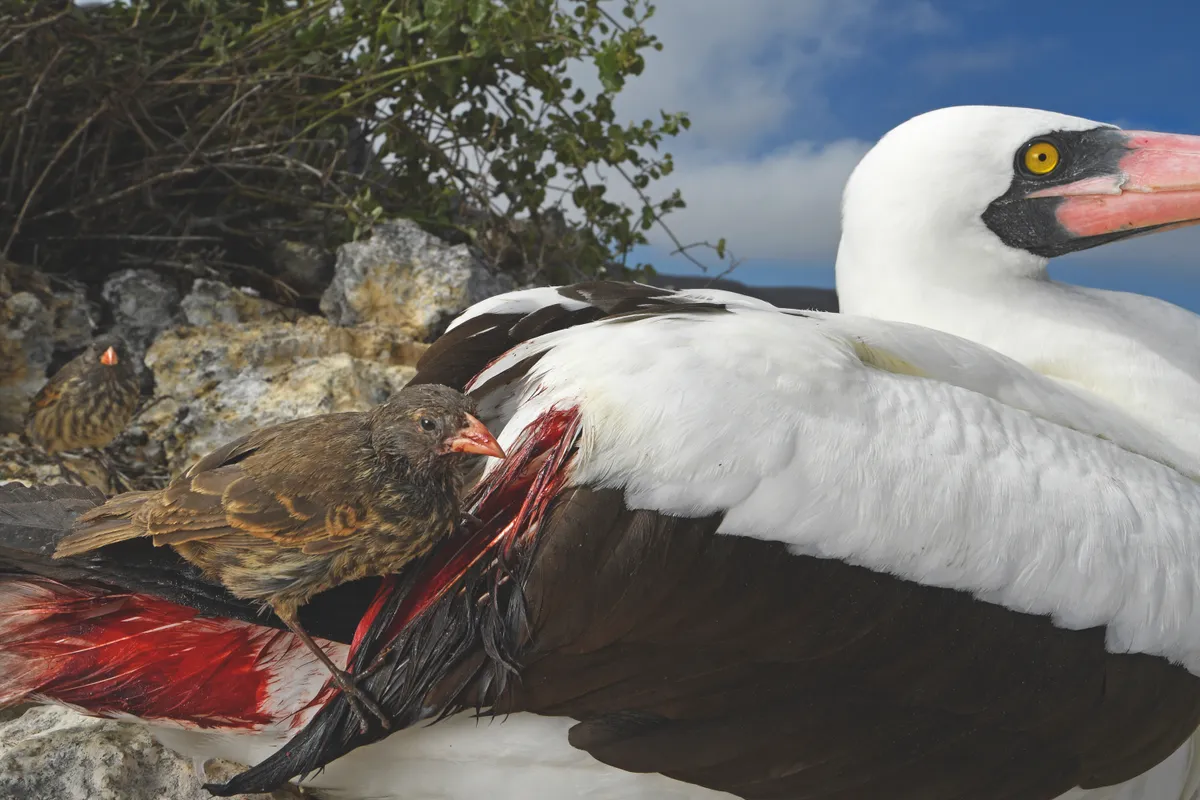
When rations run short on Wolf Island, in the remote northern Galápagos, the sharp-beaked ground finches become vampires. Their sitting targets are Nazca boobies and other large birds on the plateau. Boobies thrive here, nesting among dense cactus thickets and fishing in the surrounding ocean, but the finches have a tougher time. The island has no permanent water and little rainfall. The finches – among the species that inspired Darwin’s theory of evolution – rely on a scant diet of seeds and insects, which regularly dries up.
Pecking away at the base of booby flight feathers with their sharp beaks – a trait that may have evolved from feeding on the birds’ parasites – they drink blood to survive. "I’ve seen more than half a dozen finches drinking from a single Nazca booby," says Tom. Rather than leave and expose their eggs and chicks to the sun, the boobies appear to tolerate the vampires, and the blood loss doesn’t seem to cause permanent harm.
Working on a climate-change story (the Galapagos may offer an early warning of the effects on biodiversity of global changes), Tom had secured a rare permit to land on the island. He made it up the steep cliffs, scrambling over loose rocks to reach the plateau. For maximum impact, he shot the bloody scene at bird’s eye level to capture the one female feeding and another waiting just behind.
Winner 2018, Behaviour: Invertebrates, Mud-rolling mud-dauber by Georgina Steytler, Australia
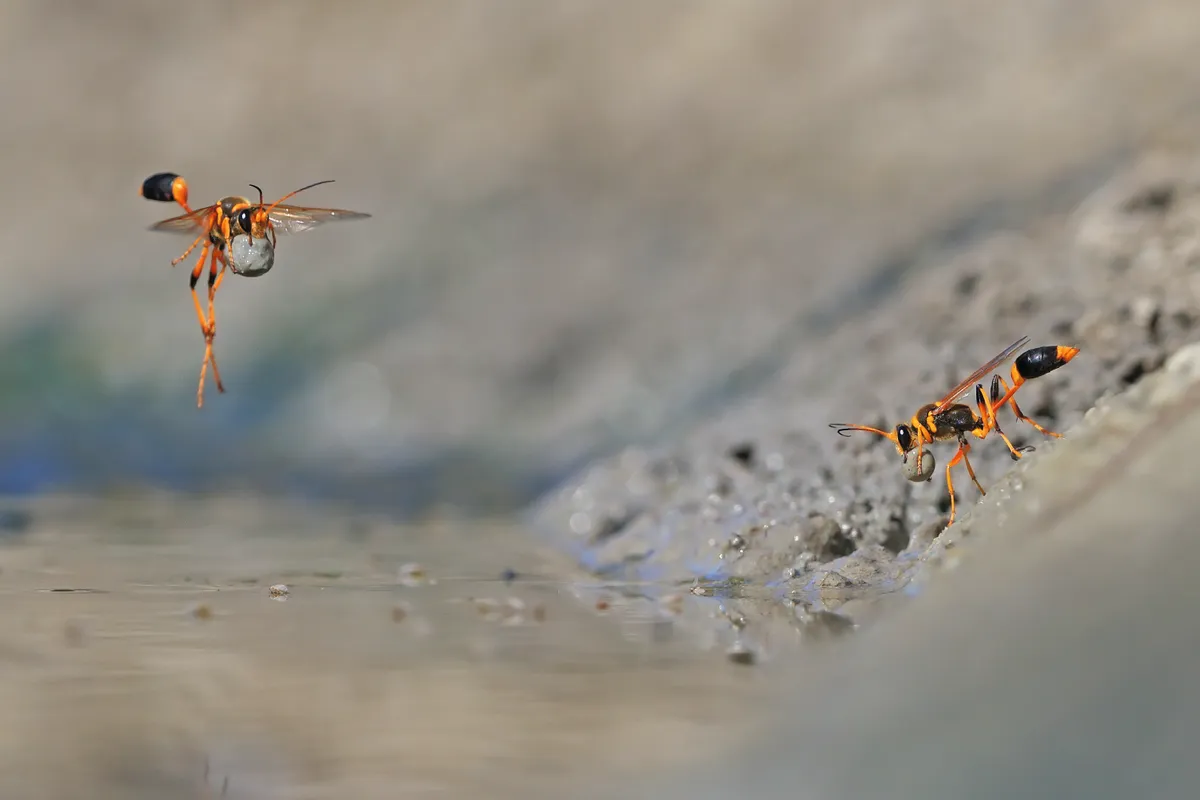
It was a hot summer day, and the waterhole at Walyormouring Nature Reserve, Western Australia, was buzzing. Georgina had got there early to photograph birds, but her attention was stolen by the industrious slender mud-dauber wasps, distinctive with their stalk-like first abdominal segments.
They were females, busy digging in the soft mud at the water’s edge, and then rolling the mud into balls to create egg chambers to add to their nearby nests. A female builds her external nest completely out of mud, cylindrical chamber by chamber, which cement together into one mass as the mud hardens. She provisions each of the dozen or more cocoon-like chambers with the paralyzed bodies of orb‑weaving spiders, laying one egg on the first spider in each chamber – usually a soft-bodied species, which is easy for a newly hatched larva to eat.
To get a good angle on the industrious mud‑daubers, Georgina lay in the mud, pre‑focused on a likely flight path and began shooting whenever a wasp entered the frame. It took hundreds of attempts to achieve her ideal shot, of two slender mud-dauber wasps, each displaying an aspect of their quintessential mud-handling skills.
Winner 2018, Behaviour: Mammals, Kuhirwa mourns her baby by Ricardo Núñez Montero, Spain
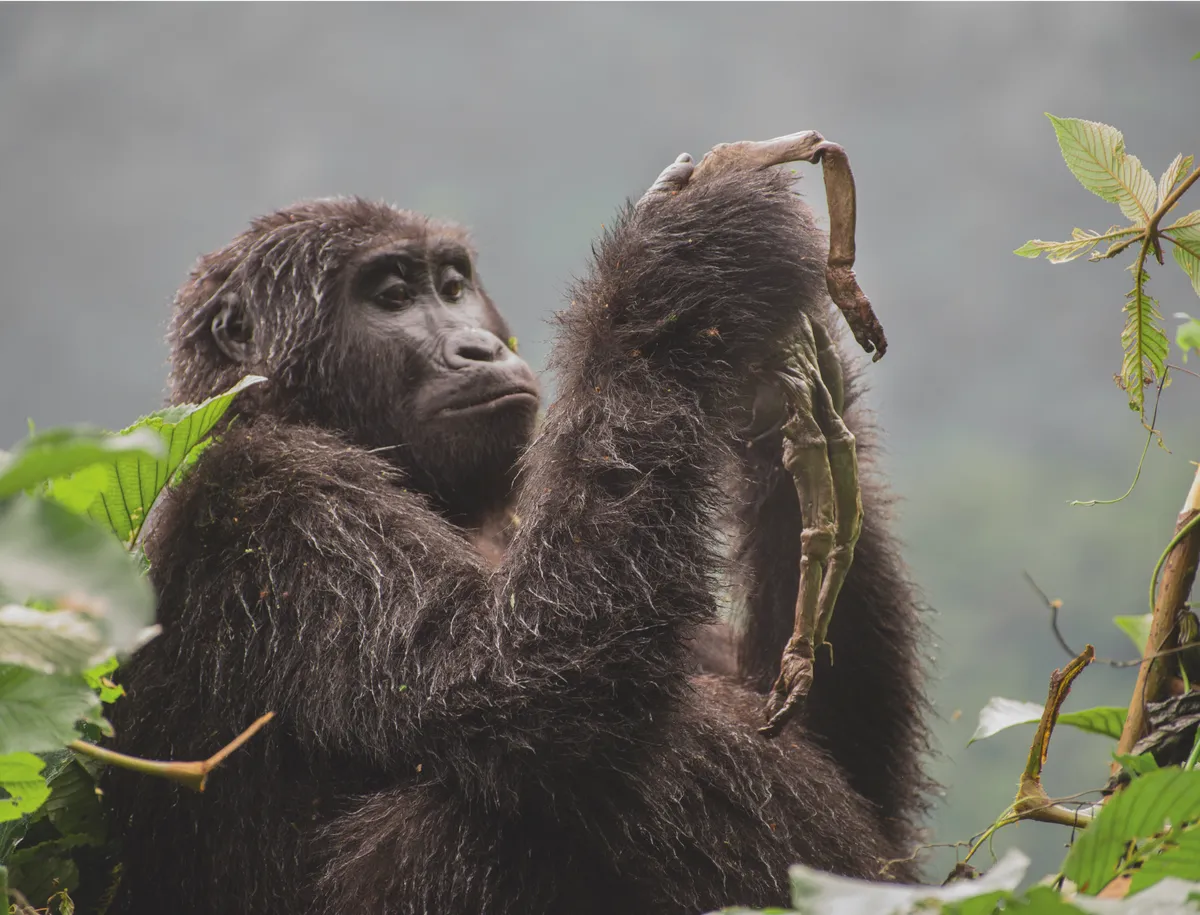
Kuhirwa, a young female member of the Nkuringo mountain gorilla family in Uganda’s Bwindi Impenetrable Forest, would not give up on her dead baby. What Ricardo first thought to be a bundle of roots turned out to be the tiny corpse. Forced by the low light to work with a wide aperture and a very narrow depth of field, he chose to focus on the body rather than Kuhirwa’s face.
Guides told him that she had given birth during bad weather and that the baby probably died of cold. At first Kuhirwa had cuddled and groomed the body, moving its legs and arms up and down and carrying it piggyback like the other mothers. Weeks later, she started to eat what was left of the corpse, behaviour that the guide had only ever seen once before.
Kuhirwa’s initial reactions to her bereavement echo responses to death seen in other species. From elephants stroking the bones of dead family members to dolphins who try to keep dead companions afloat, there is an abundance of credible evidence that many animals – ranging from primates and cetaceans to cats, dogs, rabbits, horses and some birds – behave in ways that visibly express grief, though individual reactions vary. Kuhirwa’s behaviour can be understood as mourning, without the need to speculate about her thoughts.
Winner 2018, Plants and Fungi, Desert relic by Jen Guyton by Germany/USA
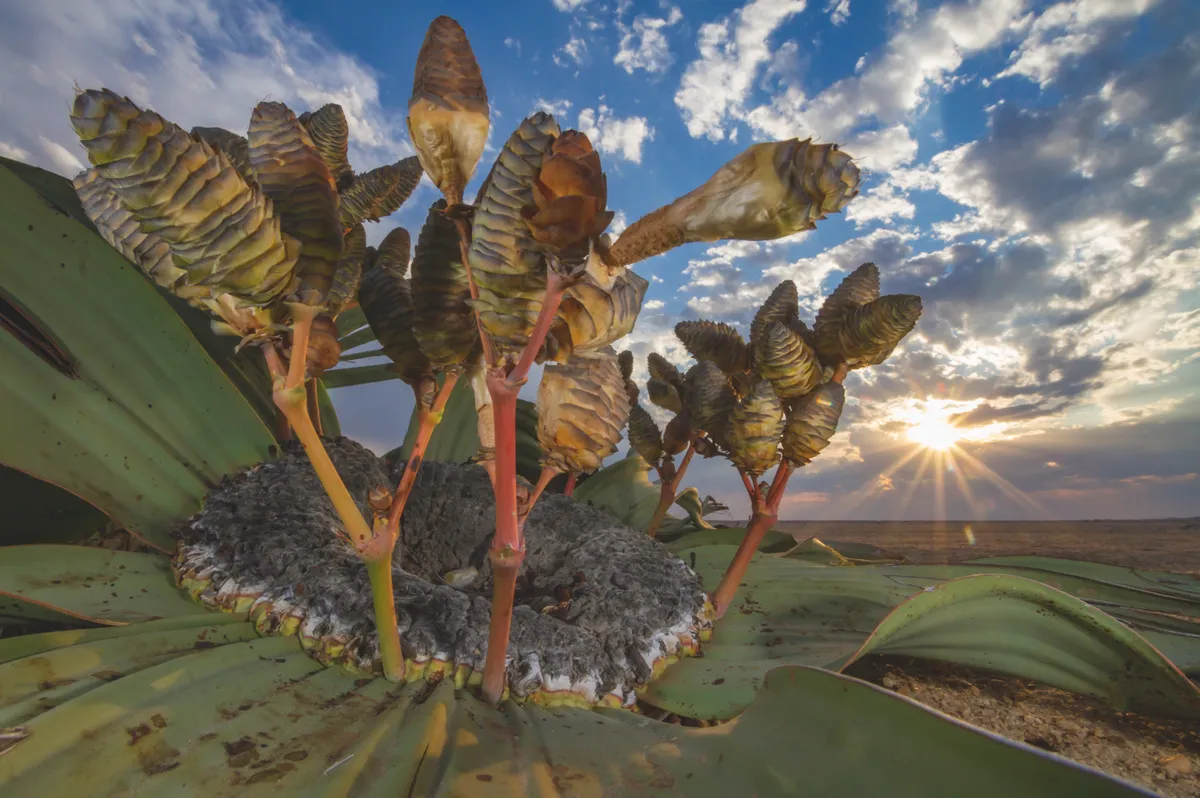
The cones of a female welwitschia reach for the skies over the Namib Desert, proffering sweet nectar to insect pollinators. These desert survivors have an extraordinary biology. There are male and female plants, both producing distinctive cones. Each plant comprises just two leaves, a stem base and a tap root. The woody stem stops growing at the apex but widens with age, forming a concave disc, but the two original seedling leaves continue to grow, gradually splitting and fraying.
With a slow growth rate and the largest specimens spanning more than 8 metres (26 feet), some may be 1,000 years old or more (twice that has been claimed). Endemic to Namibia and Angola, welwitschia endures harsh, arid conditions, usually within 150 kilometres (90 miles) of the coast, where its leaves capture moisture from sea fog.
Jen’s challenge was to find a striking way to photograph what can be seen as just a pile of old leaves. After trekking all day over hot sand, scouting widely scattered plants, Jen found one about 1.5 metres (5 feet) across, and with ‘the right shape and lively colours’. It had ripening cones, some with their papery wings ready to detach and carry the seeds away on the wind. Adopting a low, wide angle to catch the vibrant tones and to display the plant’s architecture against the expansive landscape, she started shooting just as the sun was going down and while a scattering of clouds rolled in and diffused the light.
Winner 2018, Urban Wildlife, Crossing paths by Marco Colombo, Italy
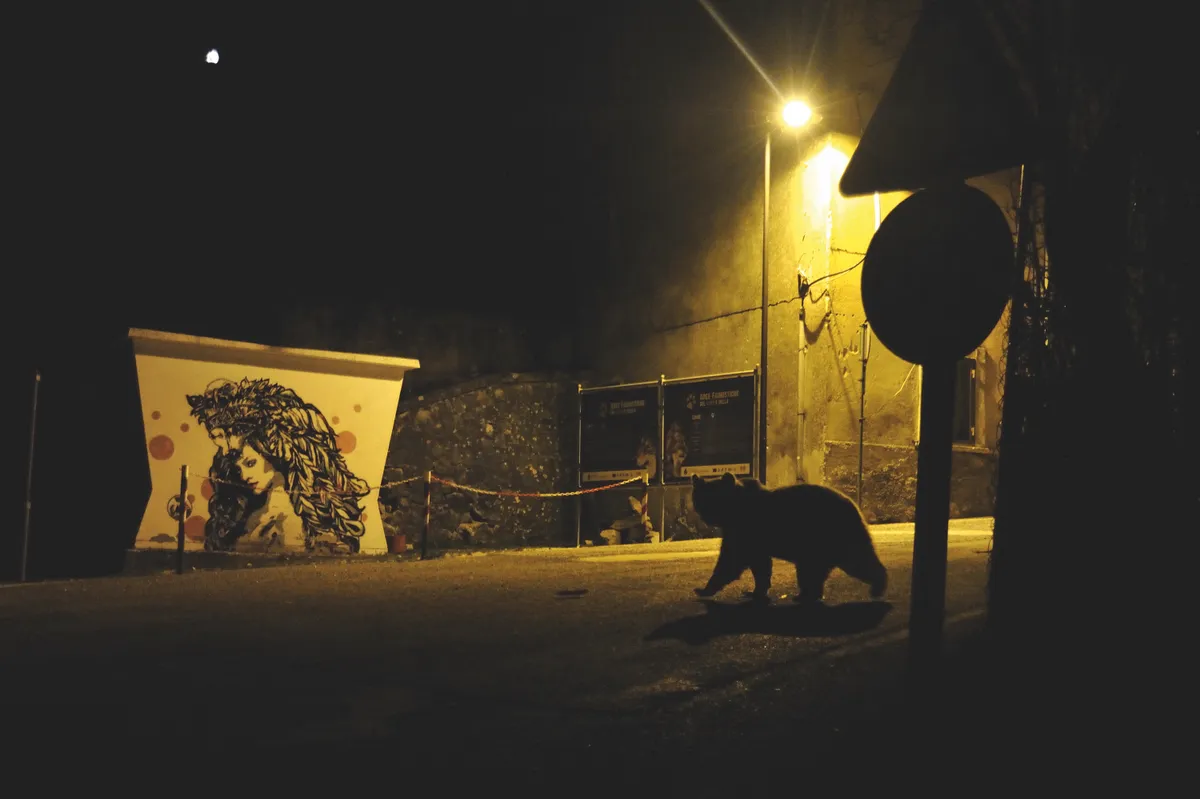
A shadowy movement caught Marco’s eye as he drove slowly through a village in the Abruzzo, Lazio and Molise National Park in Italy’s Apennine Mountains. It was late evening, and he thought there was a chance that it might be a Marsican brown bear rather than a deer waiting to cross the road. Stopping the car, he switched off the lights to avoid stressing the animal. He had just a few minutes to change lenses and prepare to take a shot through the windscreen before the bear walked out of the shadows and across the road, disappearing into the dark of the woods.
Though the light was poor, the backdrop made up for it, complete with nature-tourism posters. Most Marsican brown bears – an isolated, unaggressive and critically endangered subspecies – stay well away from humans. A few individuals, though, venture into villages to raid vegetable gardens and orchards, especially in the run-up to winter hibernation, when they need to lay down fat. This puts them at risk of being hit by cars, of retaliatory poisoning and of harassment: video clips have appeared on social media made of bears being chased by cars.
With just 50 or so bears remaining, every death is a disaster. Coexistence is possible, but only if a respectful distance is maintained. Electric fences around orchards help deter the bears from coming into the villages, and education can protect both the bears and the nature tourism they attract.
Winner 2018, Earth’s Environments, Windsweep by Orlando Fernandez Miranda, Spain
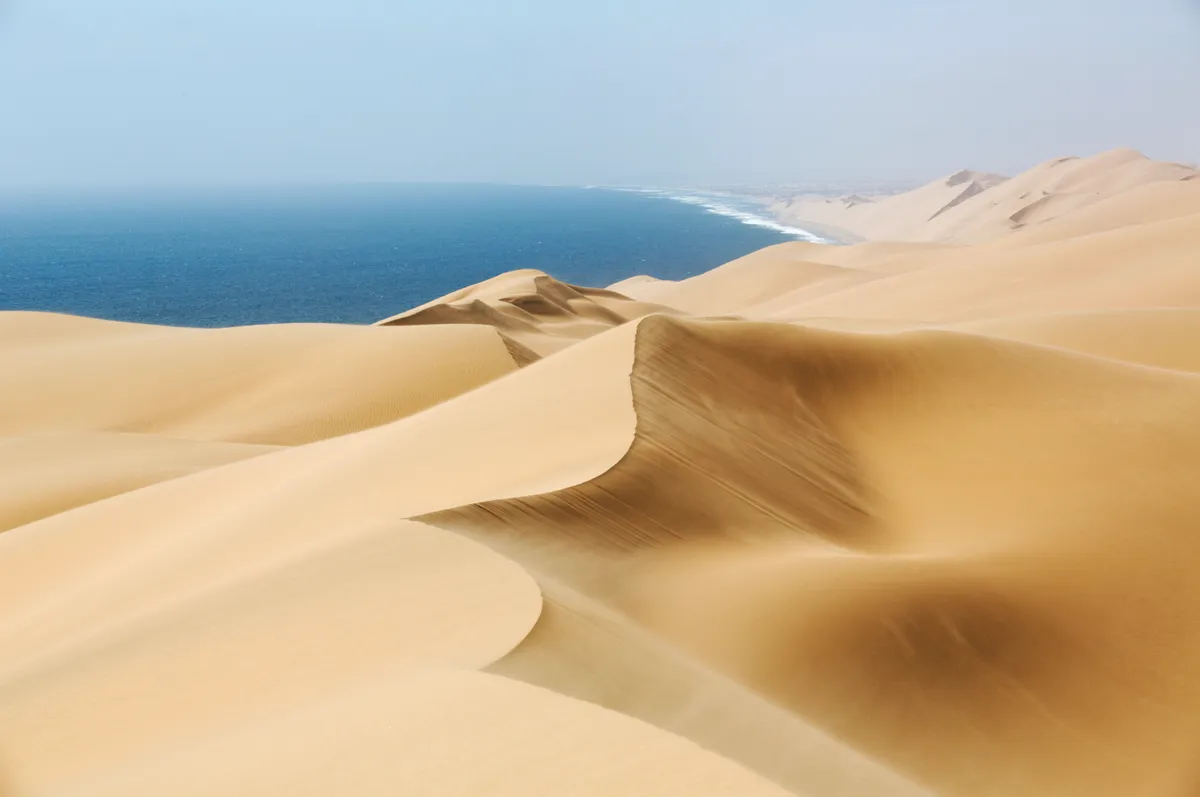
Standing at the top of a high dune on Namibia’s desert coastline, where mounds of wind-sculpted sand merge with crashing Atlantic waves, Orlando faced a trio of weather elements: a fierce northeasterly wind, warm rays of afternoon sunshine and a dense ocean fog obscuring his view along the remote and desolate Skeleton Coast.
Such eclectic weather is not unusual in this coastal wilderness. It is the result of cool winds from the Benguela Current, which flows northwards from the Cape of Good Hope, mixing with the heat rising from the arid Namib Desert to give rise to thick fog that regularly envelopes the coast. As it spills inland, the moisture from this fog is the life-blood for plants and insects in the dry dunes.
Orlando framed his shot using as a focal point the sharp ridge of sand snaking out in front, ensuring that the sweep of wind-patterned dunes to his right remained in focus, and kept the distant fog‑shrouded coast as a mysterious horizon.
Winner 2018, Wildlife Photojournalism, The sad clown by Joan de la Malla, Spain
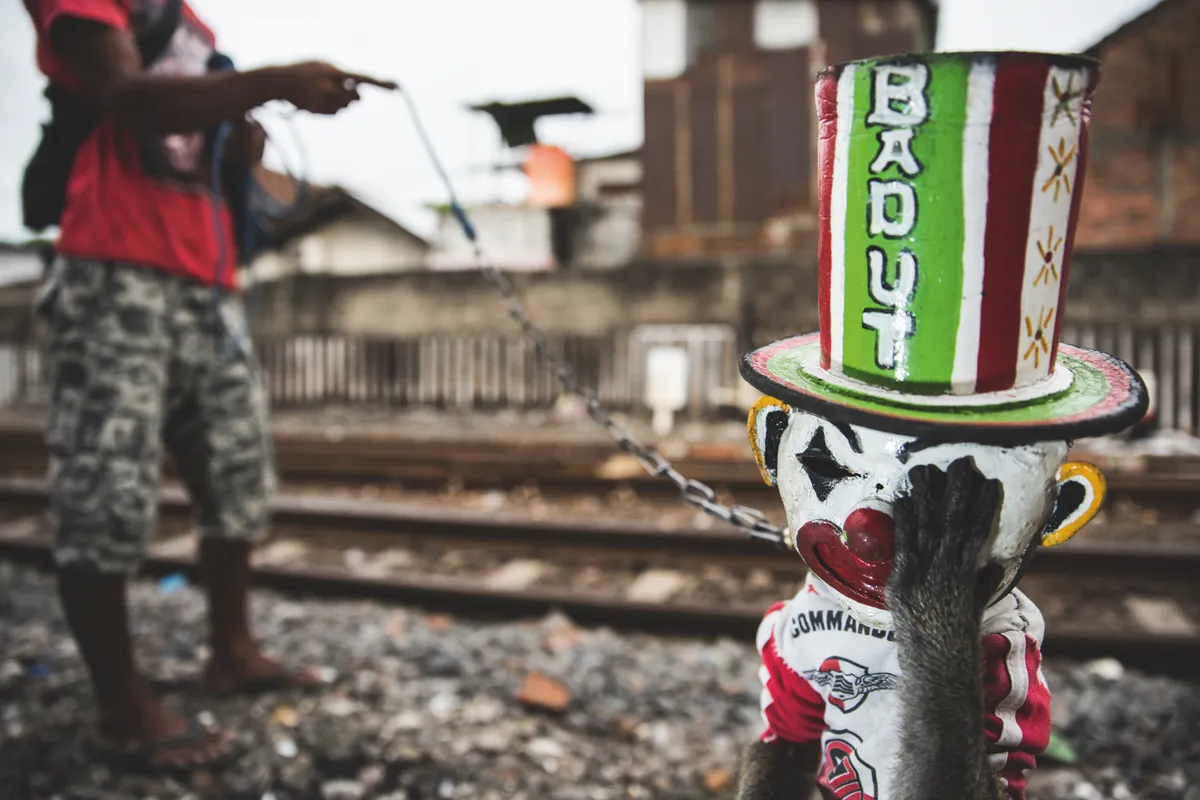
Timbul, a young long-tailed macaque, instinctively puts his hand to his face to try to relieve the discomfort of the mask he has to wear. His owner is training him to stand upright so that he can add more stunts to his street‑show repertoire (the word Badut on the hat means clown).
When he’s not training or performing, Timbul lives chained up in his owner’s yard next to a railway track in Surabaya, on the Indonesian island of Java. Should he show aggression as he gets older, his teeth might be pulled out or he will just be disposed of. Macaque street shows are banned in several cities, but still take place elsewhere in Indonesia.
The macaques often work for hours performing tricks such as dancing and riding bikes. When the owners themselves aren’t working, they might rent out the monkeys. Animal-welfare charities are working at both political and community level to reduce the suffering of these monkeys and to enforce legislation that makes it illegal to take young monkeys from the wild or trade in them without a permit.
But the welfare issues reflect other, deeper problems of social justice. Joan spent a long time gaining the trust of the monkey owners in Surabaya. ‘They are not bad people,’ he says, ‘and by doing street shows, they can afford to send their children to school. They just need other opportunities to make a living.’
Winner 2018, Wildlife Photojournalist Award: Story, Signature tree by Alejandro Prieto, Mexico
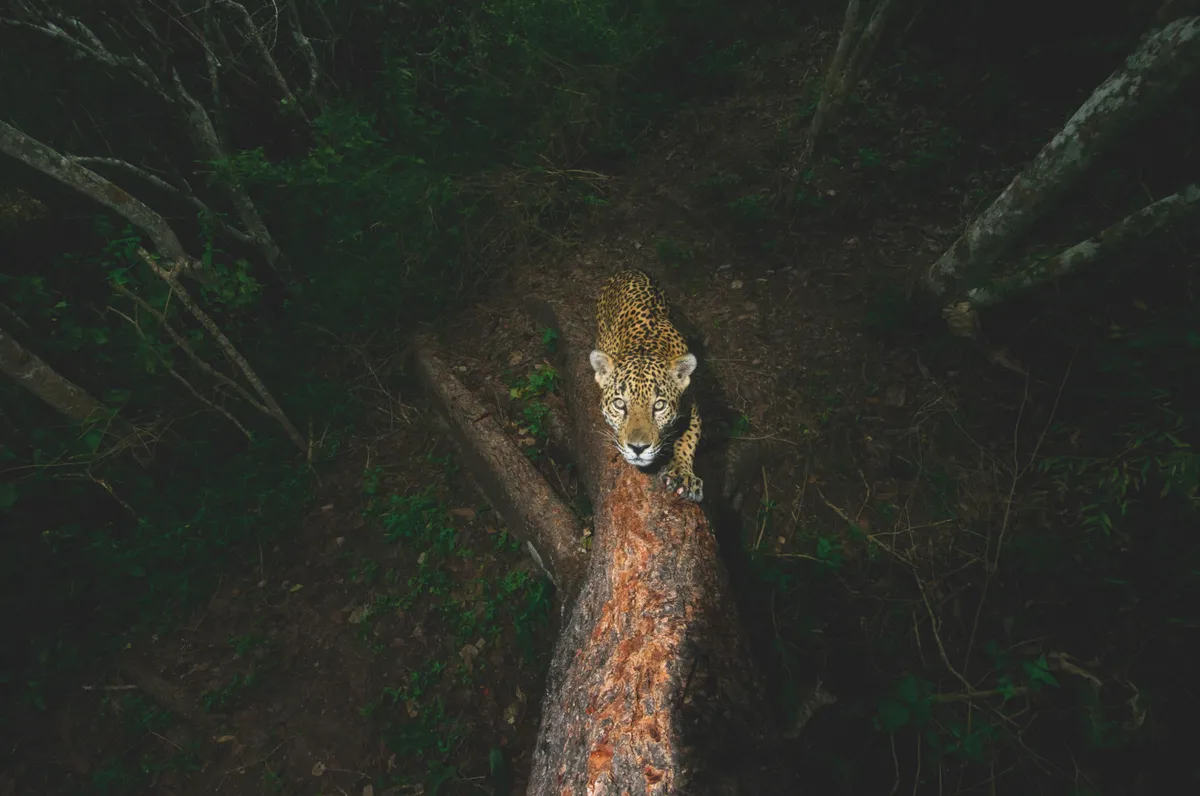
A male jaguar sharpens his claws and scratches his signature into a tree on the edge of his mountain territory in the Sierra de Vallejo in Mexico’s western state of Nayarit. The boundary-post has been chosen with care – the tree has soft bark, allowing for deep scratch marks that are a clear warning, backed by pungent scent, not to trespass.
Alejandro set up his custom-built camera trap some 6 metres (20 feet) up the tree and returned every month to change the batteries. Eight months elapsed before the jaguar eventually returned to this corner of his realm to refresh his mark.
Jaguars need vast territories to have access to enough prey. But in Mexico, habitat is being lost at a rapid rate as forest is cleared for crops or livestock or for urban development, and much of what remains is fragmented. The loss of even a small area of habitat can cut a jaguar highway between one part of a territory and another and isolate the animal to such an extent that it cannot feed itself or find a mate.
About Wildlife Photographer of the Year
Originally launched in 1965 by BBC Wildlife Magazine (then named Animals), the Wildlife Photographer of the Year (WPY) competition is a showcase for the world's best nature photography. Now in its fifty-fourth year, the competition is run by the Natural History Museum.
WPY 2018 received over 45,000 entries from both professionals and amateurs across 95 countries. The winners were announced on Tuesday 16 October in an awards ceremony at the museum. This year's exhibition opens at the museum on Friday 19 October, and runs until summer 2019.
WPY 2019 opens for entries on Monday 22 October and closes on 13 December 2018. The competition is open to photographers of all ages and abilities. Find out more on the WPY website.